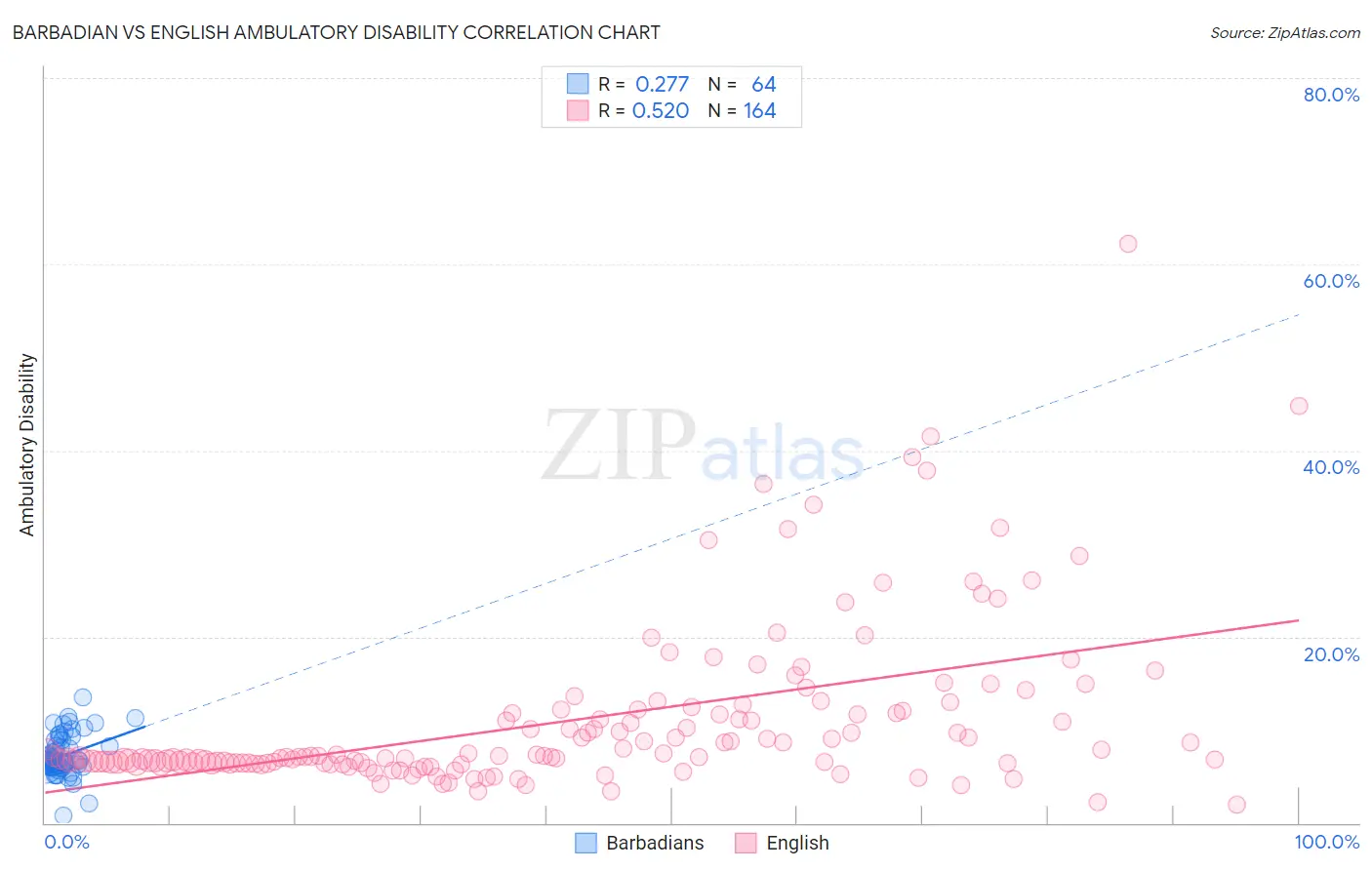Barbadian vs English Ambulatory Disability
COMPARE
Barbadian
English
Ambulatory Disability
Ambulatory Disability Comparison
Barbadians
English
6.8%
AMBULATORY DISABILITY
0.0/ 100
METRIC RATING
282nd/ 347
METRIC RANK
6.6%
AMBULATORY DISABILITY
0.4/ 100
METRIC RATING
262nd/ 347
METRIC RANK
Barbadian vs English Ambulatory Disability Correlation Chart
The statistical analysis conducted on geographies consisting of 141,286,079 people shows a weak positive correlation between the proportion of Barbadians and percentage of population with ambulatory disability in the United States with a correlation coefficient (R) of 0.277 and weighted average of 6.8%. Similarly, the statistical analysis conducted on geographies consisting of 579,179,335 people shows a substantial positive correlation between the proportion of English and percentage of population with ambulatory disability in the United States with a correlation coefficient (R) of 0.520 and weighted average of 6.6%, a difference of 2.9%.

Ambulatory Disability Correlation Summary
| Measurement | Barbadian | English |
| Minimum | 0.77% | 2.0% |
| Maximum | 13.4% | 62.2% |
| Range | 12.7% | 60.2% |
| Mean | 7.2% | 11.0% |
| Median | 6.7% | 7.1% |
| Interquartile 25% (IQ1) | 6.1% | 6.4% |
| Interquartile 75% (IQ3) | 8.6% | 11.9% |
| Interquartile Range (IQR) | 2.5% | 5.5% |
| Standard Deviation (Sample) | 2.2% | 9.0% |
| Standard Deviation (Population) | 2.2% | 8.9% |
Demographics Similar to Barbadians and English by Ambulatory Disability
In terms of ambulatory disability, the demographic groups most similar to Barbadians are Yaqui (6.8%, a difference of 0.13%), Pennsylvania German (6.8%, a difference of 0.20%), Immigrants from Caribbean (6.7%, a difference of 0.30%), Immigrants from West Indies (6.7%, a difference of 0.61%), and Jamaican (6.7%, a difference of 0.68%). Similarly, the demographic groups most similar to English are Hmong (6.6%, a difference of 0.12%), Nepalese (6.6%, a difference of 0.52%), Bahamian (6.6%, a difference of 0.58%), Guyanese (6.6%, a difference of 0.70%), and Trinidadian and Tobagonian (6.6%, a difference of 0.83%).
| Demographics | Rating | Rank | Ambulatory Disability |
| English | 0.4 /100 | #262 | Tragic 6.6% |
| Hmong | 0.3 /100 | #263 | Tragic 6.6% |
| Nepalese | 0.2 /100 | #264 | Tragic 6.6% |
| Bahamians | 0.2 /100 | #265 | Tragic 6.6% |
| Guyanese | 0.2 /100 | #266 | Tragic 6.6% |
| Trinidadians and Tobagonians | 0.2 /100 | #267 | Tragic 6.6% |
| Spanish | 0.2 /100 | #268 | Tragic 6.6% |
| French | 0.1 /100 | #269 | Tragic 6.6% |
| Slovaks | 0.1 /100 | #270 | Tragic 6.7% |
| Immigrants | Trinidad and Tobago | 0.1 /100 | #271 | Tragic 6.7% |
| French Canadians | 0.1 /100 | #272 | Tragic 6.7% |
| Whites/Caucasians | 0.1 /100 | #273 | Tragic 6.7% |
| Sioux | 0.1 /100 | #274 | Tragic 6.7% |
| Immigrants | Guyana | 0.1 /100 | #275 | Tragic 6.7% |
| Celtics | 0.1 /100 | #276 | Tragic 6.7% |
| Jamaicans | 0.1 /100 | #277 | Tragic 6.7% |
| Immigrants | West Indies | 0.1 /100 | #278 | Tragic 6.7% |
| Immigrants | Caribbean | 0.0 /100 | #279 | Tragic 6.7% |
| Pennsylvania Germans | 0.0 /100 | #280 | Tragic 6.8% |
| Yaqui | 0.0 /100 | #281 | Tragic 6.8% |
| Barbadians | 0.0 /100 | #282 | Tragic 6.8% |